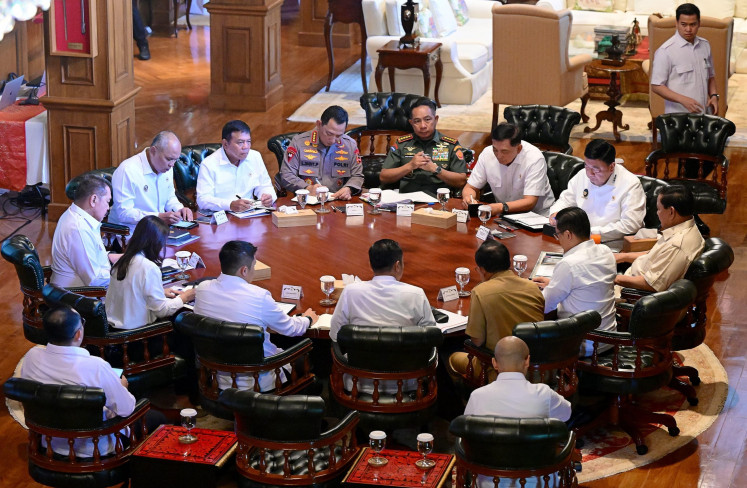Popular Reads
Top Results
Can't find what you're looking for?
View all search resultsPopular Reads
Top Results
Can't find what you're looking for?
View all search resultsThe language ecology perspective
With the legislative election having just ended, it is perhaps no exaggeration to say that our politicians (in particular) and our people (in general) have practiced democracy in a relatively mature manner
Change text size
Gift Premium Articles
to Anyone
With the legislative election having just ended, it is perhaps no exaggeration to say that our politicians (in particular) and our people (in general) have practiced democracy in a relatively mature manner. Contesting in both legislative and presidential elections, political leaders and presidential aspirants representing different political parties lived up to their pledge to hold what they called a peaceful campaign.
What can we take away from this campaign? Unlike the previous political campaign, most, if not all, political leaders seemed to have been disenchanted with the traditional campaign strategies such as street rallies and mass mobilization as a show of force, which are prone to clashes among differing supporters. In fact, they have learned from the past that such strategies are dated and result in more harm than good.
It is interesting to note that the climate of political constellation in the country hitherto has been marked with an "ideological battle" via the use of language among the contesting political parties vying for legislative seats.
While legislative candidates had their pictures, along with written promises, posted in banners, presidential candidates frequently appeared on television ads, using a variety of mechanisms to woo their prospective voters.
This shift toward using language and image mechanisms in political campaigns has demonstrated how they are effective tools for selling ideologies, to manipulate, cajole, propagate and to mask the truth. Persuasive and provocative words in campaigns ads such as Sembako murah (cheap price of basic commodities), Berjuang demi Rakyat (striving for people), and Awas! Jangan bohongi rakyat lagi (Watch! Don't lie to the people again) are perceived to be effective in invoking voters' emotions and feelings.
The use of language in public spaces alongside legislative candidates can be explained by Elana Shohamy (2006), as "all language items that are displayed in a variety of contexts in the environment". It is also referred to as language ecology.
The words displayed by legislative candidates obviously communicate a message, which consciously or not manipulate what Shohamy calls de facto language policy and practice.
Despite unofficially declared and legally unbinding, de facto language policy could become a powerful mechanism in determining voter behavior. If, for example, voters put their trust on the party's promise and think that they are being reasonable, offering their votes up, then the policy will have been a big success in shaping their behaviors.
However, it is also interesting to see that ideological battles are not limited merely to the use of persuasive, convincing, and emotion-provoking words. Linguistic markers are severely restricted in creating communicative effects. They are often redundant, context-sensitive, and therefore insufficient to achieve their intent.
If you watch a presidential campaign ad, presidential candidates sell their party ideology by going beyond mere words and other linguistic markers. They employ what is known as para-language.
According to a theory of multi-modality, communicative meanings can be deliberately and purposefully created using a variety of modes in different contexts.
That is, modes can be contextualized in order to attain desired communicative effects. Using these devices to create meaning manifest themselves in a variety of creative ways, such as through music, clothes, gestures, imagery, food, tears and laughters, among others.
A party's political ideology, and other political messages, can then be expressed by contextualizing them within a wider performance.
We watch on TV, for example, a presidential candidate conveying his political message by rolling up his sleeves, a sign of hard work. Others can be seen embracing peasants and lending a hand to victims of the Lapindo mudflow, a sign of empathy and compassion for the needy.
We also watch almost everyday campaign ads delivering parties political messages through music, images, numbers, smiles, laughters, and multiple other creative methods.
Compared with verbal means of expression, these image and language based techniques are certainly more effective in delivering political messages to lure voters. It is more real and evocative, touching all levels of the grassroots nationwide. Despite one's education levels - someone may be illiterate for example - the message is conveyed loud and clear.
A word of caution, nevertheless, is necessary here. Though the campaign period has just ended, we still have to cast our votes in the upcoming presidential election.
Prospective voters need to exercise their judgment by judiciously weighing which presidential aspirants deserve a vote. Although a political message may be anything from persuasive to subtle or overt, they are by no means free from propaganda, myth and deceit.
The writer is chief-editor of the Indonesian Journal of English Language Teaching and teaches English composition at Atma Jaya Catholic University, Jakarta.










